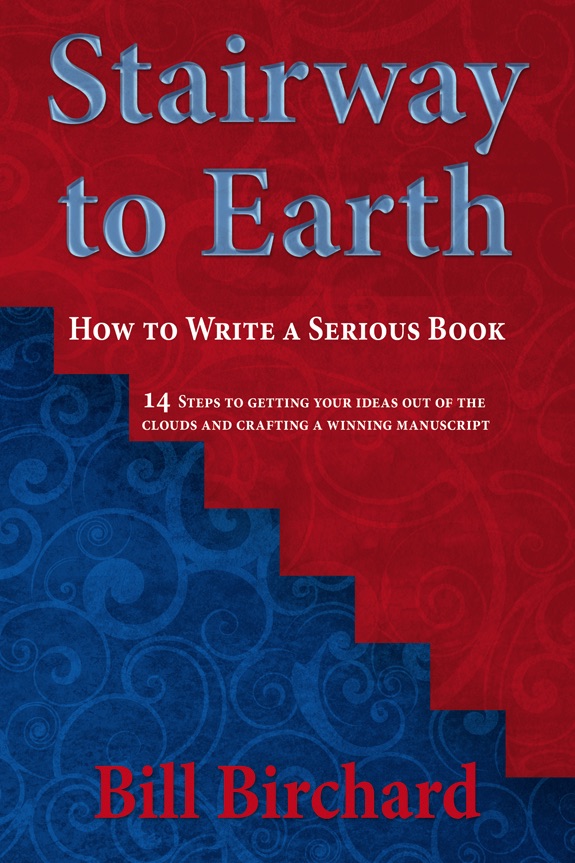Birchard Books
Bill Birchard—Writing and Book Consultant
Welcome To Bill's Book-Writing Process
The Stairway to Earth
Want to write a book?
People write nonfiction books for all kinds of reasons—to help others, build their reputation, document their expertise, advance their careers, create a consulting brand, and even make money. No matter. Everyone faces a similar problem. I call it writer’s vertigo.

You need a process
That’s why we all need some time-tested steps to reach solid ground. In the same way that engineers imagine, design, and create a blueprint for a product before they make it, authors undertake prewriting before they write. Eights steps down a stairway and out of the fog: It’s the only way to get to earth.
STEP 1: RIGHT MESSAGE

Sometimes I’m tempted to jump right to my keyboard. I want to bang out my book’s introduction while I’m hatching a new idea. But I always remind myself: Not so fast! First I do some pencil work. A pencil and paper give your initial work a playful, relaxed feel. Doodling with a pencil, you’re not making a big commitment. And you can erase!
I then write a one-sentence message for my book. And I don’t worry about eloquence. If I’m stuck, I try a few tricks: List keywords. Devise a few book titles. Test metaphors. I articulate the message when I think I’ve zeroed in on something timely and intriguing, big enough for a whole book and marketable to today’s readers. Above all, I try to capture the kernel of my message. Accuracy first!
To avoid getting prematurely tangled up in wordsmithing, keep doodling until your thinking has crystallized. Only then do you go to the keyboard. If you can’t get the message down the first day, or even the second, don’t rush it. Sleep on it. Let your unconscious take over.
Step 1: The paper trail begins
To finish this first step in the Stairway to Earth, create two electronic documents.
- Message statement: If you were to make a poster for your book, what would you put on it? A title, subtitle, and message. Try to use no more than 30 words.
- Title brainstorming: Few authors come up with the perfect title on the first go. Put down your favorite. Then log all that come to mind, serious and zany.
So that’s how how to engineer the first step in the book-writing process. This is the first stair step to earth. If you want more detail on my process, click for a free download of chapter 1.
[Image by OpenClipart-Vectors - Pixaby]
STEP 2: RIGHT ARGUMENT

Once you have a message, your next step is to expand it. Many publishers reject books because, in spite of a great idea, the message cannot be developed to book length. So elaborate the message into a sequential argument. Prove your argument will go the distance.
Like it or not, a book’s presentation is linear—not like hyperlinks on the web. One chapter comes after another, so if you start with one big gumball of an idea, you have to figure out how to arrange it into one long strand.
A simple way to do this is by dividing the topic into three parts: problem, solution, benefits. What problem in work or life are you addressing? What are you offering for help? How will this make life/work better?
Try to capture the problem, solution, and benefits precisely. If, say, the message is that one kind of leadership is better than another, work backward and identify the problem hindering that kind of leadership. What aspects of your brand of leadership make up the secret remedy? How can readers exercise your suggestions to improve work?
One of the most common mistakes for would-be authors is to repeat in later chapters what they say in earlier ones. It’s also common to make a leap of logic from one chapter to the next that's too big. Or to have the logic out of order. Make sure each chapter builds on the one before. Recast until you work out the kinks.
Step 2: The paper trail continues
To finish with the second step in the Stairway to Earth, create two new documents:
- Précis: Pretend you're writing the book jacket. In roughly one page (300-400 words), sell your reader on your book. Dramatize the problem and solution. Summarize the development. Tempt the reader with irresistible benefits. The précis mimics the tone and style of the book.
- Table of contents: Draft the table of contents. Shoot for six to twelve chapters, although there is no magic number. Provocative titles are good. Be descriptive so you can later follow the logical buildup of your argument.
By the way, if you have a literary agent, or helpful colleagues, now is the time to bounce your ideas off them.
STEP 3: RIGHT DIFFERENTIATION

How do you know you're saying something fresh? Maybe you're just writing a book someone else wrote already. Books today are “products.” Tens of thousands are published each year. To catch a publisher’s eye, yours has to distinguish itself from all the others.
A book as a product? That may seem crass. Don't let it bother you. Neither you nor your publisher wants a me-too book. You want to make a difference. So consider this step as a way to sharpen your thinking.
Differentiation takes many forms—fresh ideas, new perspective, varied chapter development, novel packaging, unique supporting material, superior writing style. Publishers demand two things above all: “authority” and “platform.” They want to know: Are you a recognized expert? And do you have a ready way to sell books—through speaking engagements, teaching, web sales, or other sales channels?
To position a book as different, start with the obvious: Visit an online bookseller (amazon.com or bn.com) and study competing books. Go to your bookstore and pore over books on the shelf. How is yours different? How can it be different? Note that it can help, not hurt, to be similar in some ways to big sellers. Publishers do want authors to demonstrate they have an established book-buying audience.
Step 3: The paper trail continues
In this third step in the Stairway to Earth, create two more documents:
- Log of competing books: When you browse online, cut and paste relevant books into a new document. Include cover images, authors, publishers, publication dates, sales ranks, and notes on competitors’ strengths and weaknesses.
- Positioning journal: Start journaling about your book’s positioning. How is it new? How can you differentiate it? Plenty of insights come from your competing books research. Analyze and speculate about ways to distinguish yourself.
With this step, you are three steps out of the clouds. Grab any chance you can to test your book direction with friends. Does it resonate?
STEP 4: RIGHT CONTENT

When I work with authors, I stress a key distinction: concept versus content. “Concept” means ideas, messages, insights, and conclusions. “Content” means anecdotes, research data, study results, case stories, expert testimony, interview transcripts. Concept is assertion. Content is evidence. You need plenty of both.
In a book, the concept runs throughout like a set of train cars. Content is like the freight the train cars carry. Many book authors go long on concept and short on content. They may even prepare their books as if extra concept can substitute for content. But train cars with little spice in them will not deliver much value. There will be too much noise, too little return on the reader’s investment.
So in this step, inventory content for every concept in the book. Ask: Do I have enough material to load each concept car with plenty of freight? Do I have valuable evidence that’s entertaining and educational? Publishers like quality freight piled high.
Step 4: The paper trail continues
In this fourth step in the Stairway to Earth, mentally weigh your my material for adequacy. Scan what you have and decide “by feel” if you have enough. If you're serious about writing the book, don't delay in using a formal, systematic process to create a research library:
- Digital reference files: Save in a special folder on your hard drive an electronic copy of all reference documents (transcripts, articles, notes, etc.). If you're unsure whether you have enough content, create a spreadsheet and allocate material by chapter. Once you really get going, use a program called EndNote (or Evernote) to strengthen you indexing and search capabilities.
- Paper reference files: Create a manila folder for each chapter. Each time yo find a shred of content, drop it in a folder. You can’t search the paper files like electronic ones, but you want a handy receptacle for storing stray gems.
STEP 5: RIGHT ORGANIZATION
